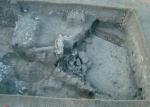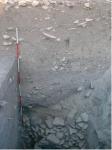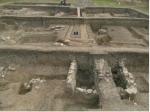Summary (English)
PLISKA (Pavel Georgiev – pavel_g@gbg.bg, Radoslav Vasilev, Tihomir Tihov, Gergana Ilieva) Debris from a stone structure dated by anonymous Byzantine folles Class A2 was discovered 40 cm deep in the central part of the fortification (Trench XX). The lower stratum contained fragments from terracotta pipes of water-conduits, a follis of Nikephoros II Phokas overstruck over an earlier follis of Romanos I Lekapenos or Constantine VII Porphyrogennetos, and an anonymous Byzantine follis Class A2. The stratum dated to the end of the 10th century at the earliest. A bath, 6.50 m by 4.50 m in size, was documented. Two shafts connected to a water-conduit were explored to the north and to the west from the bath. Sunken-floored House No. 16 was destroyed by fire. A stone stove was explored in its northeastern corner. A Christian burial was discovered under its floor. Two Christian burials of children and one of a woman were excavated in the adjacent area. Another Christian burial of an adult was discovered to the east of Trench XX. The graves dated to the end of the 10th – first half of the 11th centuries. Storage pits were explored, containing sherds from pots and amphorae of the 10th – 11th centuries. One pit contained bones from a horse, a cow, a lamb, a dog and a bird. Another pit contained an anonymous Byzantine follis Class A2. The pit-reservoir was c. 7.50 m in diameter and the well inside was over 7.10 m in depth. The large timber building of the second half of the 9th century had postholes to accommodate timber columns driven down to 1.40 m into the ground. The large timber building with foundations built in trenches dated to the first half of the 9th century and was 25 m by 6 m in size. Horizontal timber beams were placed on the bottom of the trenches. Sherds and a Byzantine lead seal of the first half of the 9th century were found. The timber buildings and structures discovered in that part of Pliska dated to the end of the 8th – 9th centuries.
- Pavel Georgiev - Shumen Branch of the Archaeological Institute and Museum
- Radoslav Vasilev - Archaeological Institute with Museum
- Tihomir Tihov - Regional Museum of History – Shumen
- Gergana Ilieva - Regional Museum of History – Shumen
Director
Team
Research Body
- Archaeological Institute with Museum
- Regional Museum of History – Shumen
- Shumen Branch of the Archaeological Institute and Museum






![Download [PDF]](/excavation/skins/fasti/images/results/download_sml.png)

